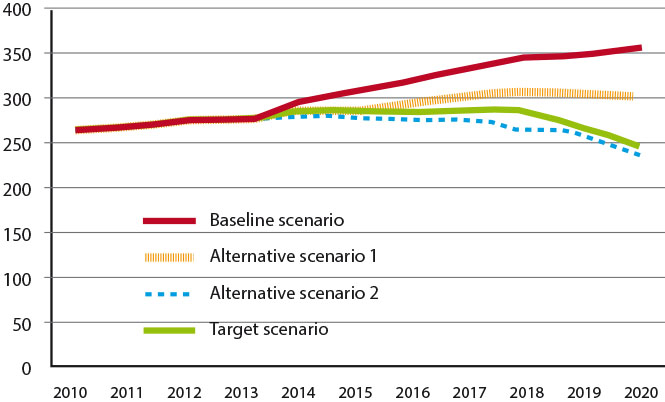The carbon reduction target must be agreed with the senior managers of the company to make sure they have perceived its strategic impact for the core activities of the company and that they will support the strategy in the long term. This requires informing them in a consistent way by presenting them the relevant actions and the long-term impacts for the company (budget, staff, image, etc.) in order to obtain a firm commitment from the management board.
Table 5 – Example of a comparative table for prioritising actions
| FIELD | ACTION | MINIMAL CRITERION (from 1 to 5) | |||
|---|---|---|---|---|---|
| Reduced Capital costs |
Reduced Operating costs |
Energy savings | Carbon emissions reduction |
||
| Weighting (from 1 to 5) | 5 | 3 | 4 | 3 | |
| Traction energy | Action 1 | 2 | 2 | 5 | 5 |
| Action 2 | 1 | 2 | 4 | 3 | |
| Action 3 | 4 | 3 | 3 | 3 | |
| Lighting in buildings | Action 1 | 2 | 4 | 3 | 4 |
| Action 2 | 4 | 2 | 2 | 2 | |
| Action 3 | 1 | 3 | 3 | 3 | |
| FIELD | ACTION | OTHER CRITERIA (from 1 to 5) | OVERALL SCORE (on 5) |
||
|---|---|---|---|---|---|
| Ease of implementation |
Employees involvement |
Corporate Image |
|||
| Weighting (from 1 to 5) | 2 | 1 | 3 | ||
| Traction energy | Action 1 | 3 | 5 | 1 | 3.10 |
| Action 2 | 2 | 5 | 4 | 2.71 | |
| Action 3 | 2 | 4 | 3 | 3.19 | |
| Lighting in buildings | Action 1 | 3 | 1 | 3 | 2.95 |
| Action 2 | 3 | 2 | 2 | 2.57 | |
| Action 3 | 1 | 1 | 4 | 2.38 | |
Weighting scale: minimal weight = 1, maximal weight = 5 – Rating scale: minimal rating = 1, maximal rating = 5
Decision tools
In order to accompany the decision-making process of the strategy, two methods have been followed in the T2K project.
Actions ranking
This method consists in ranking the potential actions with the use of a multicriteria analysis (as shown in the table on the left). By selecting the actions with the highest global score, a short list of actions can be established. This step allows choosing actions that can be implemented first to reduce the carbon emissions of the company.
Prospective scenarios
To assess the impacts of implemented actions in the long term, the company can also build prospective scenarios aiming at mitigating its emissions compared to the baseline scenario. Each scenario will combine a set of actions with their corresponding energy reduction potential. These prospective scenarios must be thoroughly compared in order to define the target scenario that will be the best performing and suit the company’s objectives and constraints within a defined period of time (e.g. until 2020 or 2030): CO2 reduction, best return on investment, corporate image, etc.
For this method, experts will have to develop a global approach requiring:
- A good knowledge on the influencing parameters in the long term (i.e. transport provision, energy costs, carbon costs, etc.);
- An ability to evaluate the implementation timeline of each action (short, middle or long term);
- A clear understanding on future technological developments.
Company involvement
Once a carbon reduction target has been decided and priority actions have been selected, a communication plan is required to mobilize internal staff and external stakeholders. This step is crucial for ensuring that acting on carbon becomes part of the corporate culture (See Chapter “Influence and Communicate”).
Fig. 24 – Example of alternative scenarios and the selection of a target scenario for a typical public transport company
